I just happened to notice an interesting leaflet on a telephone pole…
Soon after my arrival in La Paz I chanced upon a notice posted on a telephone pole on tourist-central Calle Sagárnaga advertising a weekend hands-on course in eco-friendly construction techniques. The course was offered by Arquitectos Sin Fronteras (Architects Without Borders) in Navarra, Spain. They are sponsoring a 6-month program in rural Achocalla (about an hour outside of La Paz) to build sustainable superadobe homes for villagers.
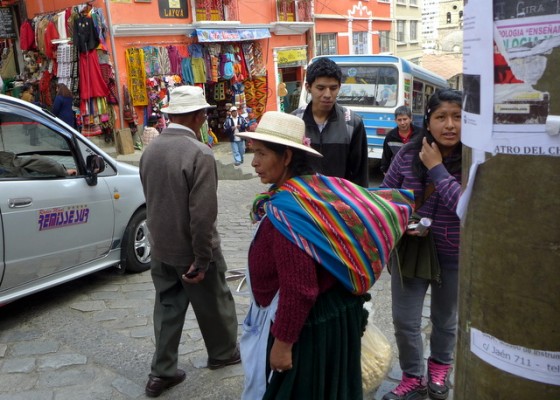
I contacted the project leader, Yoanna from Spain, who warmly welcomed me and gave me all the details. So early Saturday morning, I hopped on a trufi to Zona Sur where I met the other course members in Plaza Humboldt.
There were 13 of us for the first day, mostly Spaniards and a few Bolivians. Many of the Spaniards were travelers passing through who heard about the project through friends, but a good number of them either live here — doing research, working for the Spanish foreign office, or studying or teaching.
With an unemployment rate of nearly 50% in Spain for the under-30 crowd, all of the younger Spaniards I met were happy to be living or traveling in South America for the time being. Infinitely better than being at home right now where the economic situation is dire.
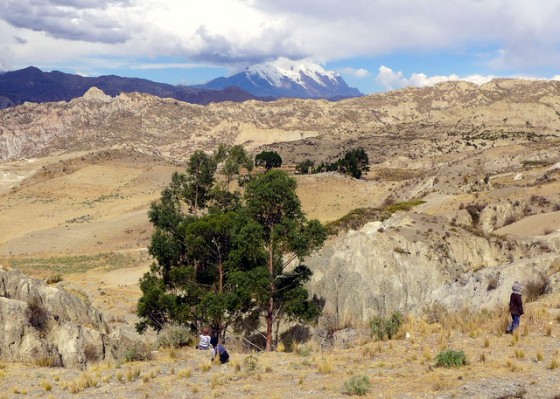
We car-pooled to the construction site in Alto Cañuma near Achocalla in the hills outside of La Paz, stunningly situated with beautiful views of the Andean Cordillera Real mountains and the white-capped Mount Illumani off in the distance. I was exhilarated to spend the weekend in such an awesome setting.

Fundación EFEL and the Suma Qamaña Children’s Center
The construction site was adjacent to the Fundación EFEL (Para el Estudio y Fomento Educativo en Latinoamerica) – The Foundation for Study and Educational Development in Latin America, an Argentine NGO which runs a school and recreation center on the premises.
Their overall project reaches out to the community in important ways including:
- A center for education and recreation for marginalized children and at-risk adolescents in the rural communities of Achocalla.
- Recreation workshops for adolescents and preadolescents.
- A book mobile for neighborhoods and rural communities in the La Paz area.
- Reading Circles and other outreach programs for children who live with their incarcerated mothers in state prisons and consequently have very limited access to structured learning environments.
A worthy organization indeed, one of so many doing great work here in Bolivia.
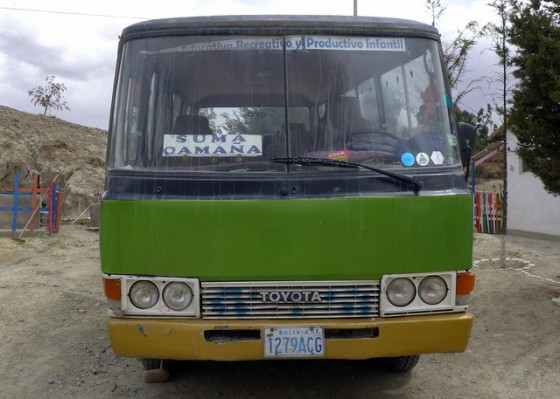
I walked around the grounds of the Suma Qamaña school, which in Aymara (the local language) means “to live well” — as in morally or upright — in balance with the spiritual and the material worlds. Children come here every day to attend class, do crafts and perform science experiments, and learn skills such as cooking (and healthful eating), agriculture and animal care, music lessons and others activities.

The grounds of the children’s center are filled with classrooms, gardens, play areas (with a superb slide that I thoroughly enjoyed), clucking hens, lazy dogs and even some llamas and alpaca (it is the Andes, after all!)

Arquitectos Sin Fronteras: Proyecto Albergue Educativo en Bolivia
The Spanish group, Architects Without Borders, is in the midst of a cool project on the grounds of the Suma Qamaña children’s center. Earlier this year they launched the Educational Housing Project in Bolivia, with the aim of building five sets of adobe homes for local villagers.
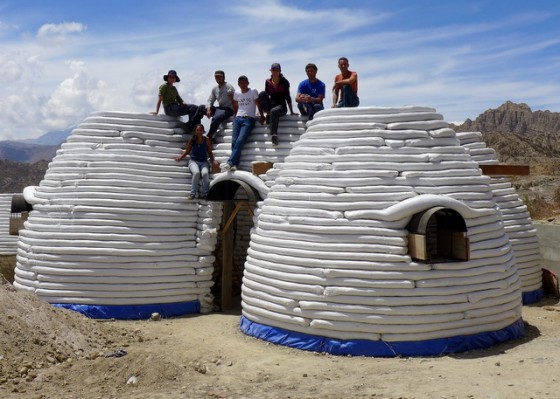
These adobe homes are relatively low cost (around 2,000€ for a 5-room structure), use earth-friendly materials and are simple to build. Applying the superadobe technique, recycled grain bags are filled with sand and 10% concrete (for added strength), then coiled upwards to form the dome-like structure. Four adjacent, smaller rooms are added on to the central “pod” which completes the house.

Once the walled structure is complete, simple adobe (dirt, straw and water) is applied to the interior and exterior walls to complete the housing unit. A basic, beautiful and highly practical home is ready for families. Not only ascetically pleasing, these homes are protect against the cold (and heat) of the harsh altiplano climate and are highly resilient to earthquakes and other hazards.
The project employs local women (and a few men) to build the homes (and will later occupy them), as well as a group of at-risk teens. It gives them income, useful skills, and the chance to be part of such a unique project and the resulting accomplishment.

Our Task: The Dry-Latrine Bathroom
Our weekend task was to fully construct one of the shared bathrooms that the five adobe homes will share (there will be 2-3 in total). Yoanna explained the dry-latrine toilet mechanism that will be installed, which is part of the really cool Fundación Sumaj Huasi currently funded by European development agencies and NGO’s. This foundation is based in nearby El Alto and is doing incredibly advanced work to improve sanitation, hygiene and promote sustainable enterprises for marginal communities.
Part of their mission is to promote eco-friendly bathrooms in impoverished communities that use an innovative dry-pit latrine system which requires no water (scarce in many parts of Bolivia) and separates solid and liquid human waste in the latrine. The segregated waste dries in the latrine over time which kills all bacteria and harmful microbes. This by-product is retrieved and used as fertilizer in private gardens, or sold to a collection company that processes it for commercial use.
In addition to being low impact to the environment and sustainable in rural areas where plumbing is difficult, these waste systems pay for themselves and potentially can earn revenue for the owners. It’s very exciting and pioneering work in Bolivia and I plan to visit their office in El Alto at some point to learn more in person.
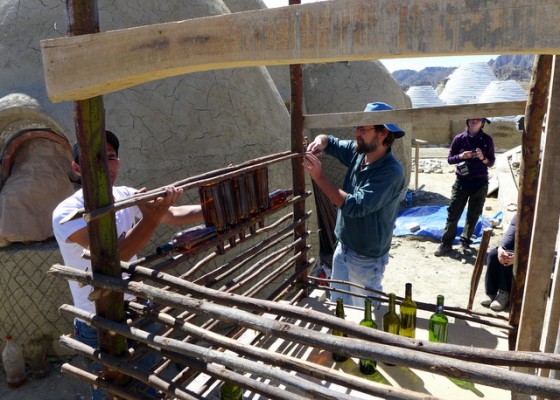
The Construction Begins
We were led by the able Elizandro Sandoval, a Bolivian eco-constructor based near Samaipata in Santa Cruz province. Learning such building techniques as wooden cane walls, recycled bottles for illumination, and multi-layered adobe plaster for coarse interior and fine exterior layers, we applied our quickly-acquired skills and started building the bathroom.

First we soaked the used beer and wine bottles in water and scraped off the labels. With the high number of Spaniards working on the project, there was no shortage of wine bottles to reclaim.

We built up the walls of the bathroom with sticks from the brush in the area, securing them to the posts with twisted wire. The bottles were placed in imaginative patterns, we even attempted a “rose window” by fastening a wheel of bottles to one wall.

After completing the wall frame, the messy part began. We rolled up our sleeves, grabbed some straw and started mixing it with the mud to make a rough adobe used to fill in-between the sticks and the bottles to solidify the wall.
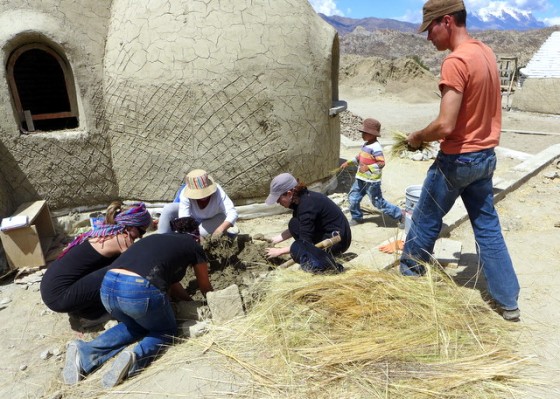
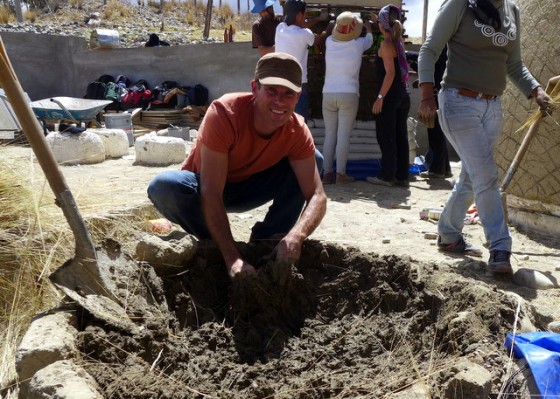
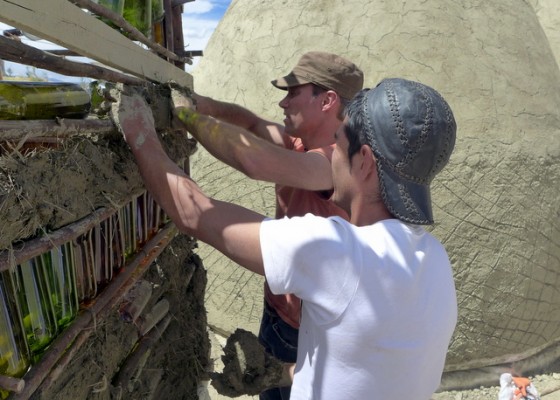
It took some time to find a workable consistency of the adobe. It requires a careful combination of water, dry earth and straw to get the right “hold”. If it’s too dry, the adobe won’t stick. If it’s too wet, it bleeds through the sticks and doesn’t form. If there is too much straw, it will fall apart.
We all soon found a productive rhythm and took turns mixing adobe and delivering it those dedicated to founding the wall. It was work but highly enjoyable. We joked and chatted, helped each other easily, took breaks to enjoy the marvelous views, and nourished ourselves with a tasty lunch of fresh fruits and vegetables, pasta salads, bread and of course huge chunks of hearty Spanish tortilla.
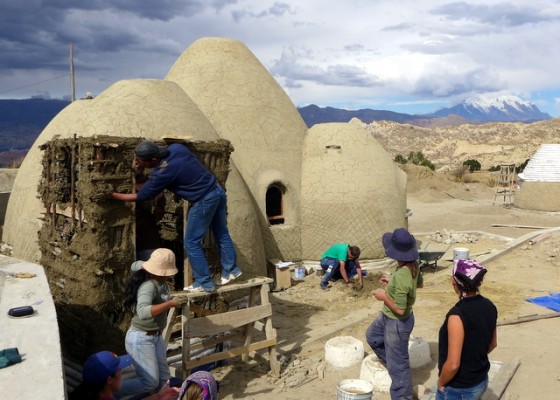
After lunch, and with the first pass of adobe done, the walls admittedly looked quite lumpy and not at all appealing. So we proceeded with the final layer, this time with finer grit, a bit more water and less straw. This coating went on much more easily and we took care to smooth out the rough spots and even out the chunks to give the walls a flat look.
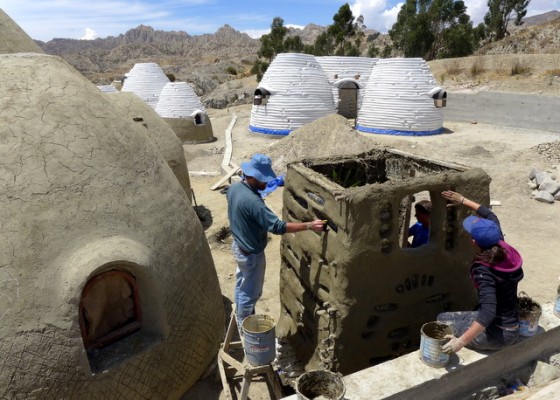
We also cleared the adobe from the bottles and sealed the edges to highlight the glass. Now the bathroom was starting to look mighty fine!
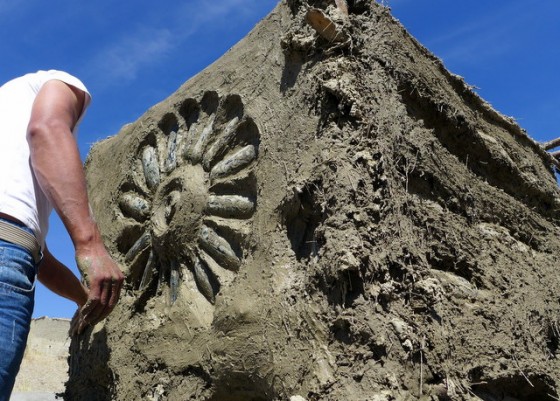
As a final touch, we added creative designs to the exterior walls, like condors and geckos and spiders, the Southern Cross, or chakana as it is known here, which carries a deep symbolism within Andean mysticism. I added a more prosaic moon and sun, figuring no outhouse would be complete without one.
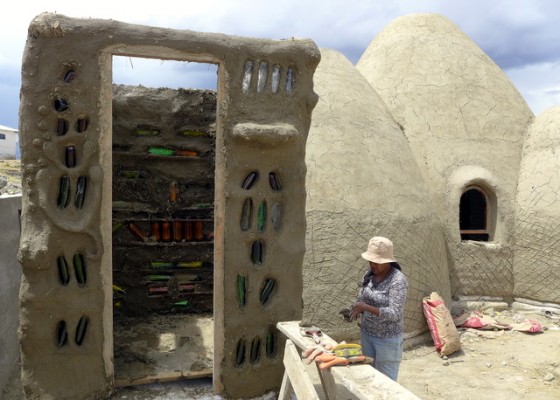
In our two days, we were able to almost complete the bathroom. The village workers would add the roof the next week, and the dry-pit latrine would be installed soon after.
So we weren’t able to inaugurate the bathroom in the conventional sense, but we were all proud of our accomplishment, flush or no flush. It was a marvelous experience for me, and I can’t imagine a better first weekend in Bolivia. I never expected that within days of landing in this beautiful new world I would have built a bathroom high in the Andes!
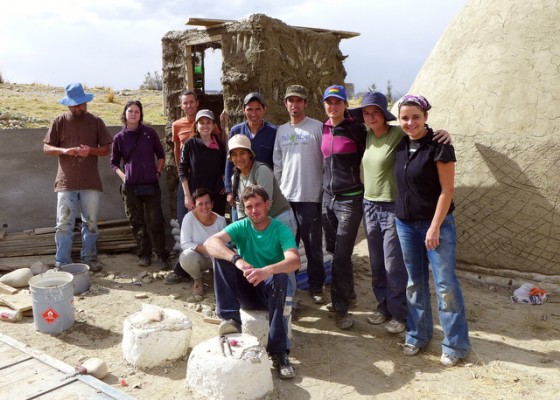
Bolivia is indeed a land of many wonderful surprises, this weekend the first of many in the coming weeks and months.

me entusiasma mucho que haya iniciativas para construir viviendas ecológicas me gustaría que puedan estas personas puedan venir a cochabamba para realizar capacitaciones y construcciones de este tipo en el parque tunari
hola Ricardo, gracias por venir a mi sitio! hoy tuve un maravilloso paseo en el Parque Tunari y yo estaba feliz encontrarte en el sendero. acabo de pasar por tu sitio http://www.parquetunari.com y tengo muchas ganas de ver y aprender más acerca del parque, me encantaría volver para más caminatas! suerte con tu proyecto en el parque, es cosa muy buena 🙂